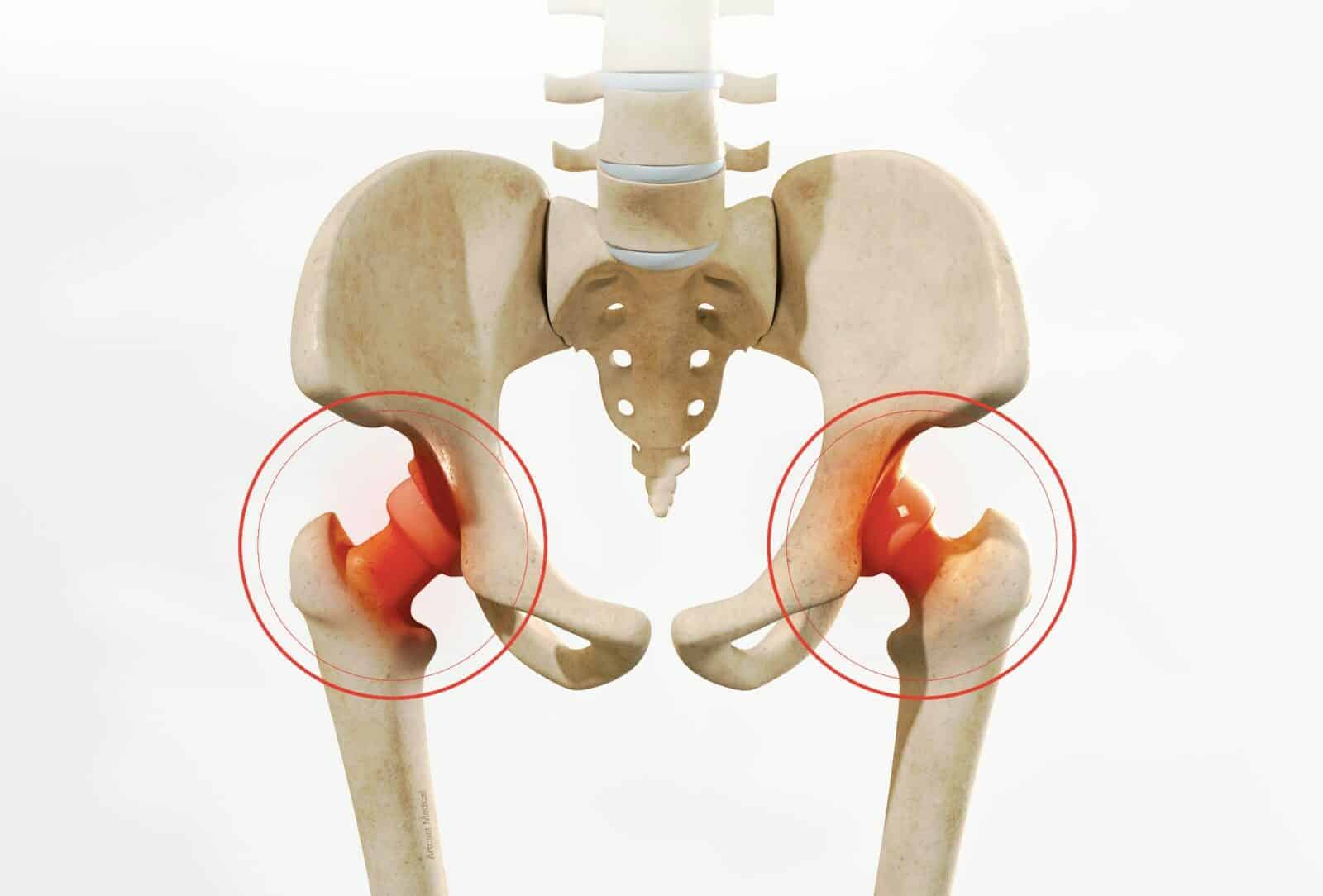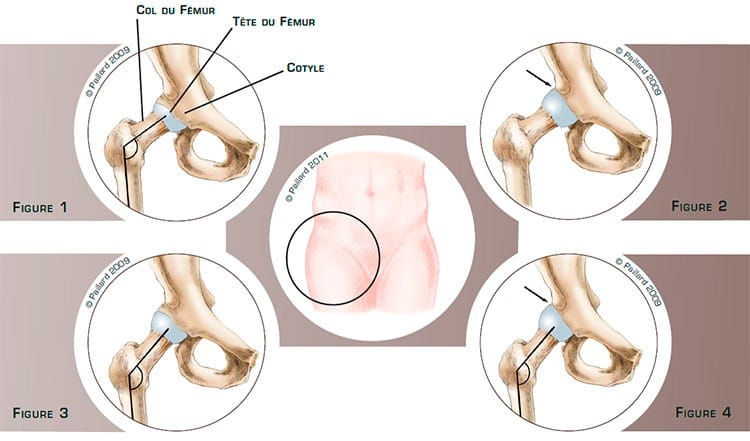Conservative hip surgery
You have hip dysplasia
You are going to undergo conservative hip surgery

You have hip dysplasia
You are going to undergo conservative hip surgery
Conservative hip surgery
The hip is the joint between the pelvis and the femur. The top of the femur is composed of a head and a neck which pivots in a socket in the pelvis called the acetabulum. The sliding surfaces are lined with cartilage and numerous muscles and tendons surrounding the capsule ensure the mobility of the hip and a balanced gait (figures 1).
Dysplasia is an abnormal shape of the hip that can lead to its premature wear.
Most often, the acetabulum is too shallow (figure 2), the angle of the femoral neck is too excessive (figure 3), or it is a combination of the two (figure 4).
The weight-bearing zone is thus reduced, increasing the pressure on the cartilage and leading to its progressive deterioration.
These modifications cause pain in the hip as well as limping and require the use of anti-inflammatories, painkillers and sometimes a walking stick.

The shape of the hip does not correct itself spontaneously and so the natural progression is the complete wear of the cartilage, with increased discomfort and difficulty in walking. We thus talk of advanced hip osteoarthritis requiring replacement.
The anti-inflammatories and painkillers that were enough to start with are no longer effective, and so the question of surgery is raised.
The objective of the operation is to relieve the part of the hip under excessive pressure, and slow wear in young subjects. This will relieve the pain and slow the progression of the osteoarthritis.
Conservative hip surgery aims to distribute the pressure on the acetabular cartilage and the femoral head better. According to the deformity, the surgery consists in increasing the depth of the acetabulum, decreasing the angle of the femoral neck, or combining the two procedures.

In the case of an excessive angle of the femoral neck, a femoral varising osteotomy is indicated:
An incision is made on the side of the hip. The top part of the femur is exposed and the femur bone is cut just below the neck using a saw (figure 5). The correction of the angle of the femoral neck is achieved by opening up the cut (figure 6). The size of the opening is calculated according to the initial deformation and controlled by a perioperative x-ray. A plate is then fixed with screws to maintain the correction (figure 7).

In the case of a shallow acetabulum, acetabular augmentation is indicated :
An incision is made in the top part of the hip and the external part of the acetabulum is exposed. A bone graft is taken from the pelvis and fixed with one or two screws to the external part of the acetabulum, just above the femoral head (figures 8 and 9).

In the case of an excessive angle of the femoral neck and an insufficient covering of the acetabulum,
the two procedures are performed at the same time through a longer incision (figure 10).
The operation lasts about one and a half hours on average, and requires around 7 days in hospital. The operation can be carried out under spinal or general anaesthesia. Your anaesthesiologist will decide with you the best type of anaesthesia according to your state of health.
After the operation, the incisions are covered with a sterile dressing, which is left in place for 10 days. The pain will be managed and monitored very closely during the post-operative period, and the treatment will be adjusted accordingly.
The day after the operation, the physiotherapist will get you up and help you to walk. In the case of an augmentation, you will have crutches to help you move around for 6 weeks so as not to put too much weight on the hip, and for two and a half months in the case of a femoral osteotomy.
The rehabilitation is carried out with your physiotherapist or in a rehabilitation centre. The objective is firstly to reduce the initial pain and maintain flexibility and mobility, then to recover muscle strength and sensations in the hip.
Driving can be envisaged after the 2nd month following an augmentation and after the 3rd month following a femoral osteotomy. You can generally return to work after the 3rd month, depending on your profession; office work can be sooner. A progressive return to gentle sports activities can generally be envisaged after the 6th month
In addition to the risks associated with any surgery and the anaesthetic, there are some risks specific to this surgery :
This list of risks is not exhaustive. Your surgeon can provide you with any additional explanations and will be available to discuss the advantages, disadvantages and risks of each specific case with you.
The results of this technique are well known as the procedure is over 40 years old. An improvement in pain is observed in over 90 % of cases. Normal walking without limping is generally recovered in the 3rd month post-op in the case of an augmentation and in the 6th month post-op in the case of a femoral osteotomy. The resumption of activities is often unrestricted.
Contrary to replacements, the hip remains totally natural and all types of sports activities are possible. Nevertheless, certain demanding activities involving extreme movements of the hip or running can promote the deterioration of the cartilage and comprise the long-term result.
The beneficial effect of conservative hip surgery is on average about fifteen years, thus delaying hip replacement by as many years.
Laissez votre commentaire